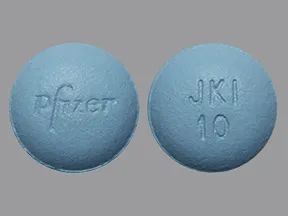

Discontinue tofacitinib in patients that have experienced a myocardial infarction or stroke.ThrombosisThrombosis, including pulmonary embolism, deep venous thrombosis and arterial thrombosis have occurred in patients treated with tofacitinib and other Janus kinase inhibitors. Patients who are current or past smokers are at additional increased risk. Patients who are current or past smokers are at additional increased risk.Epstein Barr virus-associated posttransplant lymphoproliferative disorder has been observed at an increased rate in renal transplant patients treated with tofacitinib and concomitant immunosuppressive medications.Major Adverse Cardiovascular EventsRA patients 50 years of age and older with at least one cardiovascular risk factor, treated with tofacitinib 5 mg twice daily or tofacitinib 10 mg twice daily, had a higher rate of major adverse cardiovascular events (MACE) (defined as cardiovascular death, myocardial infarction, and stroke), compared to those treated with TNF blockers. In RA patients, a higher rate of malignancies (excluding NMSC) was observed in patients treated with tofacitinib 5 mg twice a day or tofacitinib 10 mg twice a day compared with TNF blockers.Lymphomas and lung cancers were observed at a higher rate in patients treated with tofacitinib 5 mg twice a day or tofacitinib 10 mg twice a day in RA patients compared to those treated with TNF blockers. Tofacitinib oral tablets/oral solution 10 mg twice daily (or a tofacitinib extended-release tablet 22 mg once daily) dosage is not recommended for the treatment of RA or PsA.MalignanciesMalignancies, including lymphomas and solid tumors, have occurred in patients treated with tofacitinib and other Janus kinase inhibitors used to treat inflammatory conditions.

Patients with invasive fungal infections may present with disseminated, rather than localized, disease.Bacterial, viral, including herpes zoster, and other infections due to opportunistic pathogens.The risks and benefits of treatment with tofacitinib should be carefully considered prior to initiating therapy in patients with chronic or recurrent infection.Patients should be closely monitored for the development of signs and symptoms of infection during and after treatment with tofacitinib, including the possible development of tuberculosis in patients who tested negative for latent tuberculosis infection prior to initiating therapy.MortalityIn a large, randomized, postmarketing safety study in rheumatoid arthritis (RA) patients 50 years of age and older with at least one cardiovascular (CV) risk factor comparing tofacitinib 5 mg twice a day or tofacitinib 10 mg twice a day to tumor necrosis factor (TNF) blockers, a higher rate of all-cause mortality, including sudden cardiovascular death, was observed with tofacitinib 5 mg twice a day or tofacitinib 10 mg twice a day. Treatment for latent infection should be initiated prior to tofacitinib use.Invasive fungal infections, including cryptococcosis and pneumocystosis. Patients should be tested for latent tuberculosis before tofacitinib use and during therapy.

Most patients who develop these infections were taking concomitant immunosuppressants such as methotrexate or corticosteroids.If a serious infection develops, interrupt tofacitinib until the infection is controlled.Reported infections include:Active tuberculosis, which may present with pulmonary or extrapulmonary disease. Serious InfectionsPatients treated with tofacitinib are at increased risk for developing serious infections that may lead to hospitalization or death. Oral route (Tablet Tablet, Extended Release Solution)


 0 kommentar(er)
0 kommentar(er)
